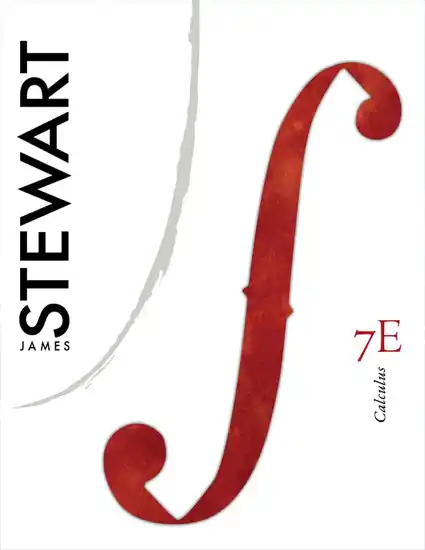Description
Contents
Preface xi
To the Student xxiii
Diagnostic Tests xxiv
A Preview of Calculus 1
- Functions and Limits 9
- Four Ways to Represent a Function 10
- Mathematical Models: A Catalog of Essential Functions 23
- New Functions from Old Functions 36
- The Tangent and Velocity Problems 44
- The Limit of a Function 50
- Calculating Limits Using the Limit Laws 62
- The Precise Definition of a Limit 72
- Continuity 81
Review 93
Principles of Problem Solving 97
- Derivatives 103
2.1 Derivatives and Rates of Change 104
Writing Project – Early Methods for Finding Tangents114
2.2 The Derivative as a Function 114
2.3 Differentiation Formulas 126
Applied Project – Building a Better Roller Coaster140
2.4 Derivatives of Trigonometric Functions 140
2.5 The Chain Rule 148
Applied Project – Where Should a Pilot Start Descent? 156
2.6 Implicit Differentiation 157
Laboratory Project – Families of Implicit Curves 163
2.7 Rates of Change in the Natural and Social Sciences 164
2.8 Related Rates 176
2.9 Linear Approximations and Differentials 183
Laboratory Project – Taylor Polynomials 189
Review 190
Problems Plus 194
- Applications of Differentiation 197
3.1 Maximum and Minimum Values 198
Applied Project- The Calculus of Rainbows 206
3.2 The Mean Value Theorem 208
3.3 How Derivatives Affect the Shape of a Graph 213
3.4 Limits at Infinity; Horizontal Asymptotes 223
3.5 Summary of Curve Sketching 237
3.6 Graphing with Calculus and Calculators 244
3.7 Optimization Problems 250
Applied Project – The Shape of a Can 262
3.8 Newton’s Method 263
3.9 Antiderivatives 269
Review 275
Problems Plus 279
- Integrals 283
4.1 Areas and Distances 284
4.2 The Definite Integral 295
Discovery Project – Area Functions 309
4.3 The Fundamental Theorem of Calculus 310
4.4 Indefinite Integrals and the Net Change Theorem 321
Writing Project – Newton, Leibniz, and the Invention of Calculus 329
4.5 The Substitution Rule 330
Review 337
Problems Plus 341
- Applications of Integration 343
5.1 Areas Between Curves 344
Applied Project – The Gini Index 351
5.2 Volumes 352
5.3 Volumes by Cylindrical Shells 363
5.4 Work 368
5.5 Average Value of a Function 373
Applied Project – Calculus and Baseball 376
Review 378
Problems Plus 380
- Inverse Functions: 383
Exponential, Logarithmic, and Inverse Trigonometric Functions
6.1 Inverse Functions 384
Instructors may cover either Sections 6.2 –6.4 or Sections 6.2*–6.4*. See the Preface.
6.2 Exponential Functions and Their Derivatives 391 6.2* The Natural Logarithmic Function 429
6.3 Logarithmic Functions 404 6.3* The Natural Exponential Function 429
6.4 Derivatives of Logarithmic Functions 410 6.4* General Logarithmic and Exponential Functions 437
6.5 Exponential Growth and Decay 446
6.6 Inverse Trigonometric Functions 453
Applied Project – Where to Sit at the Movies 461
6.7 Hyperbolic Functions 462
6.8 Indeterminate Forms and l’Hospital’s Rule 469
Writing Project – The Origins of l’Hospital’s Rule 480
Review 480
Problems Plus 485
- Techniques of Integration: 487
7.1Integration by Parts 488
7.2 Trigonometric Integrals 495
7.3 Trigonometric Substitution 502
7.4 Integration of Rational Functions by Partial Fractions 508
7.5 Strategy for Integration 518
7.6 Integration Using Tables and Computer Algebra Systems 524
Discovery Project – Patterns in Integrals 529
7.7 Approximate Integration 530
7.8 Improper Integrals 543
Review 553
Problems Plus 557
- Further Applications of Integration 561
8.1 Arc Length 562
Discovery Project – Arc Length Contest 569
8.2 Area of a Surface of Revolution 569
Discovery Project – Rotating on a Slant 575
8.3 Applications to Physics and Engineering 576
Discovery Project – Complementary Coffee Cups 586
8.4 Applications to Economics and Biology 587
8.5 Probability 592
Review 599
Problems Plus 601
- Differential Equations 603
9.1 Modeling with Differential Equations 604
9.2 Direction Fields and Euler’s Method 609
9.3 Separable Equations 618
Applied Project – How Fast Does a Tank Drain? 627
Applied Project – Which Is Faster, Going Up or Coming Down? 628
9.4 Models for Population Growth 629
9.5 Linear Equations 640
9.6 Predator-Prey Systems 646
Review 653
Problems Plus 657
- Parametric Equations and Polar Coordinates 659
10.1 Curves Defined by Parametric Equations 660
Laboratory Project – Running Circles around Circles 668
10.2 Calculus with Parametric Curves 669
Laboratory Project – Bézier Curves 677
10.3 Polar Coordinates 678
Laboratory Project – Families of Polar Curves 688
10.4 Areas and Lengths in Polar Coordinates 689
10.5 Conic Sections 694
10.6 Conic Sections in Polar Coordinates 702
Review 709
Problems Plus 712
11- Infinite Sequences and Series 713
11.1 Sequences 714
Laboratory Project – Logistic Sequences 727
11.2 Series 727
11.3 The Integral Test and Estimates of Sums 738
11.4 The Comparison Tests 746
11.5 Alternating Series 751
11.6 Absolute Convergence and the Ratio and Root Tests 756
11.7 Strategy for Testing Series 763
11.8 Power Series 765
11.9 Representations of Functions as Power Series 770
11.10 Taylor and Maclaurin Series 777
Laboratory Project – An Elusive Limit 791
Writing Project – How Newton Discovered the Binomial Series 791
11.11 Applications of Taylor Polynomials 792
Applied Project – Radiation from the Stars801
Review 802
Problems Plus 805
12- Vectors and the Geometry of Space 809
12.1 Three-Dimensional Coordinate Systems 810
12.2 Vectors 815
12.3 The Dot Product 824
12.4 The Cross Product 832
Discovery Project – The Geometry of a Tetrahedron 840
12.5 Equations of Lines and Planes 840
Laboratory Project -Putting 3D in Perspective 850
12.6 Cylinders and Quadric Surfaces 851
Review 858
Problems Plus 861
13- Vector Functions 863
13.1 Vector Functions and Space Curves 864
13.2 Derivatives and Integrals of Vector Functions 871
13.3 Arc Length and Curvature 877
13.4 Motion in Space: Velocity and Acceleration 886
Applied Project – Kepler’s Laws 896
Review 897
Problems Plus 900
14- Partial Derivatives 901
14.1 Functions of Several Variables 902
14.2 Limits and Continuity 916
14.3 Partial Derivatives 924
14.4 Tangent Planes and Linear Approximations 939
14.5 The Chain Rule 948
14.6 Directional Derivatives and the Gradient Vector 957
14.7 Maximum and Minimum Values 970
Applied Project – Designing a Dumpster 980
Discovery Project – Quadratic Approximations and Critical Points 980
14.8 Lagrange Multipliers 981
Applied Project – Rocket Science 988
Applied Project – Hydro-Turbine Optimization 990
Review 991
Problems Plus 995
15- Multiple Integrals 997
15.1 Double Integrals over Rectangles 998
15.2 Iterated Integrals 1006
15.3 Double Integrals over General Regions 1012
15.4 Double Integrals in Polar Coordinates 1021
15.5 Applications of Double Integrals 1027
15.6 Surface Area 1037
15.7 Triple Integrals 1041
Discovery Project – Volumes of Hyperspheres 1051
15.8 Triple Integrals in Cylindrical Coordinates 1051
Discovery Project – The Intersection of Three Cylinders 1056
15.9 Triple Integrals in Spherical Coordinates 1057
Applied Project- Roller Derby 1063
15.10 Change of Variables in Multiple Integrals 1064
Review 1073
Problems Plus 1077
16 Vector Calculus 1079
16.1 Vector Fields 1080
16.2 Line Integrals 1087
16.3 The Fundamental Theorem for Line Integrals 1099
16.4 Green’s Theorem 1108
16.5 Curl and Divergence 1115
16.6 Parametric Surfaces and Their Areas 1123
16.7 Surface Integrals 1134
16.8 Stokes’ Theorem 1146
Writing Project – Three Men and Two Theorems 1152
16.9 The Divergence Theorem 1152
16.10 Summary 1159
Review 1160
Problems Plus 1163
17- Second-Order Differential Equations 1165
17.1 Second-Order Linear Equations 1166
17.2 Nonhomogeneous Linear Equations 1172
17.3 Applications of Second-Order Differential Equations 1180
17.4 Series Solutions 1188
Review 1193
Appendixes A1
A Numbers, Inequalities, and Absolute Values A2
B Coordinate Geometry and Lines A10
C Graphs of Second-Degree Equations A16
D Trigonometry A24
E Sigma Notation A34
F Proofs of Theorems A39
G Graphing Calculators and Computers A48
H Complex Numbers A55
I Answers to Odd-Numbered Exercises A63
Index A135









Reviews
There are no reviews yet.